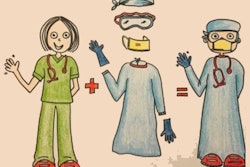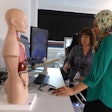
As the COVID-19 crisis recedes, radiology departments will return to normal operations. But the transition will not be as easy as flipping a switch, and they will have to balance clinical assessment, ethical judgment, and logistical planning, write Irish and U.S. authors in an article published on 4 May in the Journal of the American College of Radiology (JACR).
As the COVID-19 crisis recedes, radiology departments will return to normal operations. But the transition will not be as easy as flipping a switch.
Right now, adult and pediatric radiology departments are curtailing imaging studies, but what happens after that's no longer the case? The primary aim for healthcare systems should be to avoid straining departments, according to Drs. Aisling Snow and George A. Taylor.
"Radiology departments worldwide have been severely affected by a period of COVID-19-induced imaging austerity that will reach beyond the peak of the pandemic," wrote Snow, from the radiology department at the University of Dublin, Trinity College, and Taylor from Harvard Medical School in Boston. "Each department needs to rapidly take stock of the known and estimated future effects and begin to implement a strategy for returning to normal function."
A 4-pronged approach
Snow and Taylor recommend four steps as radiology departments start to ramp up their operations after the pandemic eases:
- Forming a taskforce
- Reviewing system capabilities
- Recovery process design
- Creating a clear communication strategy
The taskforce should include radiologists, administrators, and modality specialist radiologic technologists and radiographers. A unified approach to imaging workload realignment is ideal and necessitates a relationship between referrers and the radiology taskforce, the authors added.
"Documenting each referrer's preferred method of communication about patients has already proved helpful in one of our hospitals," they wrote.
Also, in terms of documentation, Snow and Taylor advise using available systems such as RIS, PACS, and electronic health records to note decisions regarding the imaging care of patients.
When it comes to reviewing system capabilities, the taskforce must take stock of staffing and budget, they added.
With staffing, the taskforce must determine staff capabilities and locations of work to match them with available facilities and clinical need. Finances are also a factor here because in the U.S., for instance, healthcare systems are struggling to pay staff already employed. Hiring additional staff could prove challenging, as could purchasing additional equipment.
The recovery process will require juggling rescheduled patients and seeing those who were already scheduled. Some departments may be able to redistribute deferred cases without altering the scheduled appointments of other patients. For sites whose waiting lists were already long, or that have limited capacity to return to high output levels, "a full reevaluation of all cases on the waiting list may be justified to allow equity of prioritization across all specialties and referrers," they added.
The reevaluation will require assessing urgent and emergent imaging, time-critical imaging, imaging of known versus potential disease, and screening programs. In the U.S., health insurance status and preapproval for imaging will further complicate matters.
"Referrer and radiologist input will be necessary in order to determine if a study is still required, whether the correct study is ordered, and, if so and in the context of available resources, how quickly it should be and can be performed," the authors wrote.
Communicating the taskforce's plans to corporate management, radiology staff, referrers, and patients/parents will also help everything to run smoother.
"Proactive and careful management should allow departments to actively manage a recovery process that will last well beyond the immediate critical care crisis," Snow and Taylor concluded. "Planning our own recovery will ultimately protect patients and staff and enable us to respond accordingly as the uncertainty of the coming months unfolds."
















